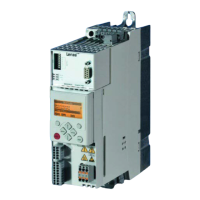10.6.1 Identifier
The principle of the CAN communication is based on a message-oriented data exchange
between a transmitter and many receivers. All nodes can transmit and receive quasi-
simultaneously.
The identifier, also called COB-ID (abbr. for communication object identifier), is used to
control which node is to receive a transmitted message. In addition to the addressing, the
identifier contains information on the priority of the message and the type of user data.
The identifier consists of a basic identifier and the node address of the node to be
addressed:
Identifier (COB-ID) = basic identifier + node address (node ID)
Exception:
The identifier for process data/heartbeat/emergency objects as well as network
management and sync telegrams is freely assigned by the user (either manually or
automatically by the network configurator), or is permanently assigned.

